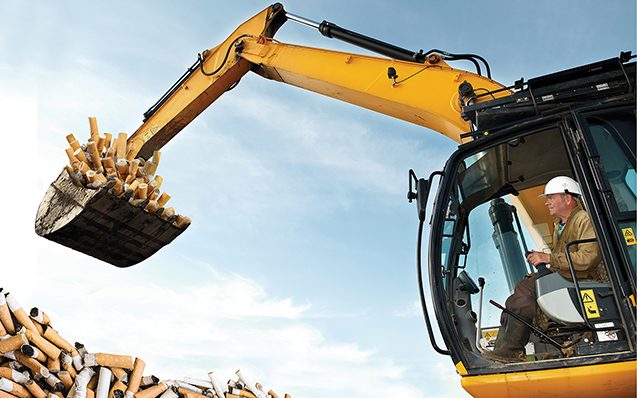Anita Dessaix is the Manager of Cancer Prevention at the Cancer Institute New South Wales. Her focus is on primary prevention of cancer, specifically managing tobacco control, melanoma awareness and lifestyle cancers.
Anyone who has tried to quit smoking, succeeded in quitting smoking or who has had a loved one go through the experience would understand that it can be challenging. The nicotine in cigarettes has been compared to heroin for its level of addictiveness which is why it can be difficult to kick the habit.
 There’s no doubt that many people in the mining industry experience a range of unique challenges that can make quitting smoking even harder. Working in an industry dominated by long shifts in stressful jobs, isolation from community and family support, and living in situations where opportunities for recreation and relaxation are limited, all add pressure.
There’s no doubt that many people in the mining industry experience a range of unique challenges that can make quitting smoking even harder. Working in an industry dominated by long shifts in stressful jobs, isolation from community and family support, and living in situations where opportunities for recreation and relaxation are limited, all add pressure.
Quitting smoking gives you a real opportunity to look after your lungs and protect them from damage. People in the mining industry have extra reason to take special care of their lungs as they are already at more risk of exposure to high volumes of dust and diesel exhaust fumes which we know contribute to lung disease and cancer.
What is important for you to remember is that whilst quitting smoking can be hard, not quitting is even harder and there’s never going to be that ‘perfect time’ to quit.
The stark facts are that smoking remains the leading cause of preventable death in Australia, with up to two thirds of lifetime smokers dying from their addiction, half of those before they reach retirement age. In an industry with such a strong focus on preventing harm amongst its workers through rigorous safety protocols, the mining industry has many people exposing themselves to this major killer on a daily basis with every cigarette they smoke.
If you are a smoker, you may turn to cigarettes to relieve stress; however the truth is that smoking increases heart rate and blood pressure, only long term weight gain, however evidence now shows that this is not the case.
The good news is that making the decision to quit smoking, no matter how long you’ve been smoking for, is one of the best things you can do to improve your health and wellbeing. Blood pressure reduces and lung function improves, along with enjoying improved senses of taste and smell. An added bonus is that quitting smoking can have a positive effect on physical appearance, including reducing the likelihood of wrinkles, looking older than you are, and avoiding yellowing teeth and bad breath.
Making the brave decision to choose a future as a non-smoker also has knock-on benefits for your family, friends and work mates who don’t smoke. Generally non-smokers who live with smokers are 20-30 per cent more likely to develop lung cancer, while children in smoking households are also more likely to have asthma and other lung conditions. In short, quitting helps you protect the people you care about.
One of the biggest immediate gains from ditching the smokes is the immediate fattening of your bank balance. A pack-a-day smoker can save on average $6,400 a year just by quitting. That’s enough for a skiing holiday or a week on a tropical island, a huge 3D TV or two front row VIP tickets to the AFL grand final.
What all of this means, is that while acknowledging that quitting smoking might be one of the toughest things you’ll do, the pay-offs are huge and the losses from continuing to smoke are too high to ignore. Most people already have some understanding of the negative effects of smoking and the benefits of quitting, but knowing and taking action are two very different things. The hard work comes when you decide to do the right thing by yourself, your family, your friends and your workmates by stubbing out for good.
Any doubting feelings that you might slip-up, that you may not succeed, shouldn’t be a deterrent from starting out on a quit journey today. Every attempt at quitting brings you closer to stubbing out for good, so keep at it! It’s like learning to ride a bike.
Another important thing to remember is that while some might find it easier to quit than others, if you’re struggling you don’t need to go it alone. Help is at hand, even for people who are far away from the support of family and friends. Quitline, a free quit smoking telephone support service, can help you to make a plan to quit, backed up with advice and support along your quit journey. A team of Quitline advisors are at the ready to provide free, confidential, professional support and advice, to celebrate triumphs and to keep you on track. Participating in the free Quitline call back service, has been proven to significantly increase chances of successfully quitting so it really is worth considering calling on this support.
For some people, sharing their experiences with others in the same position can be a key support. iCanQuit.com.au provides free access to an online community where you can share your experiences and read about the challenges and triumphs of others. You can also access information about methods to quit and use tools to track your quit smoking journey and the money that you are saving.
Once you’ve made the decision to quit, consider sharing your plans with workmates, friends and family. Asking them not to smoke when they’re around you can help reduce your temptation to smoke. Around two thirds of smokers intend to quit in the next six months and one in four smokers are planning to quit in the next 30 days, so you might even be able to rally the troops around you and quit as a group. Quitting in this way means that you are tackling your individual challenges as a team. You can use the support of others to lean on during difficult times and to celebrate milestones with.
| TIME SINCE QUITTING | HOW YOUR HEALTH BENEFITS |
| 20 minutes | Your heart rate reduces. |
| 12 hours | The level of poisonous carbon monoxide in your blood reduces. |
| 2-12 weeks | Your risk of a heart attack begins to reduce and your lung function improves making exercise easier. |
| 1-9 months | Coughing and shortness of breath decreases. |
| 1 year | Your risk of coronary heart disease is halved. |
| 5 years | Your risk of mouth, throat and oesophageal cancer and stroke decreases. |
| 10 years | Your risk of lung cancer is halved and your risk of bladder, kidney and pancreatic cancer decreases. |
| 15 years | Your risk of coronary heart disease and overall death fall to the risk of someone who has never smoked. |
Now you know the facts around smoking and tips to successfully quit, it is the time to get serious. To get information, tools and advice from a community of supporters to help you quit, head to iCanQuit.com.au. Learn from others in the same situation and if you want, share your own personal story. To get support and advice from a professional Quitline advisor, call Quitline on 13 7848.
Good luck, be brave and make the change for your health, your family, your finances and your future.
“Generally non-smokers who live with smokers are 20-30 per cent more likely to develop lung cancer…”
PROFILE
ANITA DESSAIX
 Anita Dessaix, Manager of Cancer Prevention, has been with the Cancer Institute NSW since 2006. Over this time, her focus has been on the primary prevention of cancer, specifically managing the tobacco control, melanoma awareness and lifestyle cancers portfolios.
Anita Dessaix, Manager of Cancer Prevention, has been with the Cancer Institute NSW since 2006. Over this time, her focus has been on the primary prevention of cancer, specifically managing the tobacco control, melanoma awareness and lifestyle cancers portfolios.
Anita has spearheaded highly successful social marketing campaigns, such as the well known sun protection campaign ‘There’s nothing healthy about a tan’ and the ‘Voice within’ anti-tobacco campaign. She was also involved in the implementation of graphic health warnings on cigarette packaging.
REFERENCES
1] Tobacco smoking and all-cause mortality in a large Australian cohort study: findings from a mature epidemic with current low smoking prevalence, 2015, BMC Medicine.
2] “Mortality in relation to smoking: 50 years’ observation on male British doctors”, (2004) British Medical Journal, vol. 328, no.7455, p. 1519.














Add Comment